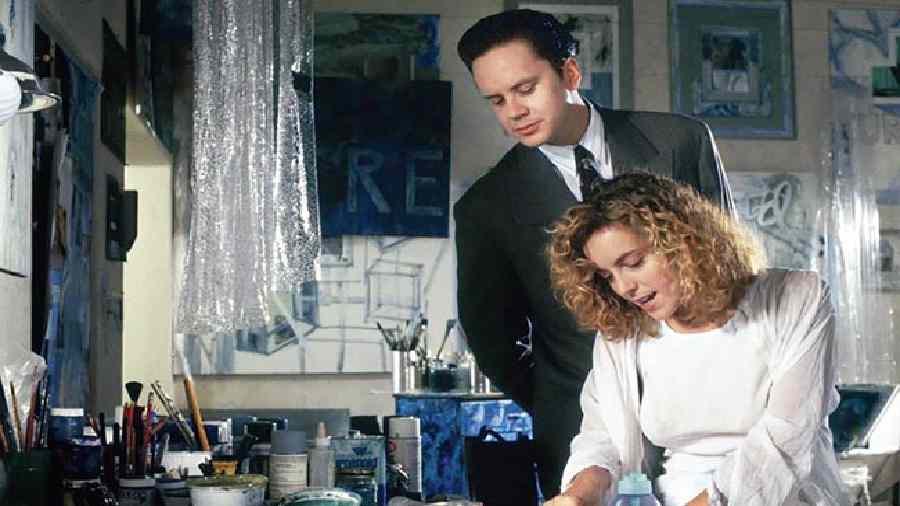I was just thinking what an interesting concept it is to eliminate the writer from the artistic process. If we could just get rid of these actors and directors, maybe we’ve got something here,” says Griffin Mill (Tim Robbins), who works as a vice-president at a movie studio, where he listens to film pitches with an air of detachment. Griffin is the reluctant anti-hero in Robert Altman’s The Player, an acidic exploration of the subculture of commercialism in Hollywood, which turns 30 this year. Adapted from the 1988 Michael Tolkin novel, Altman’s incomparable portrait of Hollywood still remains endlessly surprising. So much has aged since The Player, it almost feels like time travel, and yet nothing has changed at all.
In the breathtaking introduction scene alone — which lasts over a good seven minutes and follows actors, producers, and executives on a studio lot— Altman miraculously establishes the setting, the time and the main character. Seated in his studio office, Mill is passively listening to a pitch for “The Graduate, Part 2”. It would be about Ben and Elaine, who eloped in the original, but this film takes place 25 years later, where they are living with Mrs Robinson. Now she’s “had a stroke… so can’t talk… it’ll be funny. Dark, weird, and funny. And with a stroke.” Mill’s response? “I like it, I like it.” If you remember Sunset Boulevard as the best film made about Hollywood, The Player turns it over to you for scrutiny.
Griffin is quietly crumbling under the series of threats he receives in the form of postcards in his office. It is apparently from a writer whose idea he had stolen after one discussion. Griffin said he would call the writer back, but of course he never did. “I’ll get back to you” is his concurrent response to pitches still now. The writer says he is going to kill him. Who is sending him these postcards? Griffin reaches for his secretary’s appointment book. The point is that he has been using and lying to so many writers that he can never really know. Still he narrows it down to one name: David Kahane (Vincent D’Onofrio), and finds himself stalking his way to a revival showing of The Bicycle Thief to meet the man. He then follows him back to the parking lot and in the heat of the moment, kills him.
The Player then shifts tone and genre, with Altman establishing a seamless transition from noir to thriller-like intensity, with sporadic bursts of comedy as Griffin tries to protect his position and pass off as innocent. He also gets oddly attached to the dead man’s painter wife, June Gudmundsdottir (Greta Scacchi). He sees a strange man following him everywhere.
Additionally there is the entry of Larry Levy (Peter Gallagher) who has just transferred from Fox, and is intending to replace him. These links are joined together meticulously by editor Geraldine Peroni, where the sequences seamlessly smell of improvisation and intention. It is deeply Hollywoodised, but beyond its institutionalised self-esteem. Altman aims at corporatsation, which extends as a form of the side effect of commercialisation. Even if The Player takes place in a specific era where digital markets and franchises were not yet fussed over, it fascinatingly evokes the sense of predicament where arts and commerce would be tossed around without a care. Griffin is capable of murder, as he is capable of manipulation. Yet, he is not capable of getting a movie made.
One can’t help but feel for Griffin, even as we, the audience, are the only accomplice to his horrible acts, perhaps because of his smart understanding of the business he is in. He simply wants to wink his way through all the white lies and bankrupt moralist tendencies. Robbins walks this fine line between deceit and dread without missing a beat.
The Player essentially plays out through the wicked manoeuvres of Griffin, and Robbins makes sure each of them land correctly. Altman even said how he infused a lot of himself into Griffin, justifiably so, as someone who is grinning at the system while staying within it. Who is to blame then? In a tight close-up at the police station, Griffin’s eyes stop directly at the screen, at us. We, the audience, knew Griffin all along. Did we forsee the ending? Do we participate, three decades later, in the current illusion of franchise cinema? We, the audience, are the ones who are complicit then.










